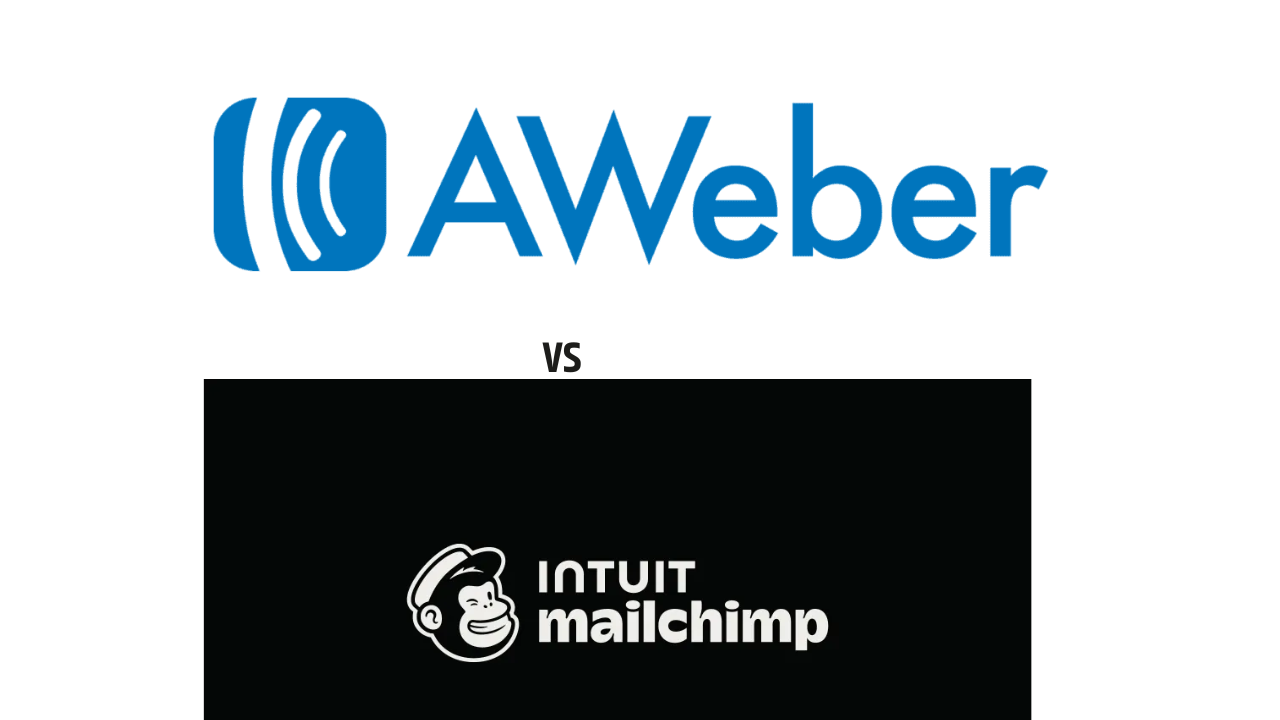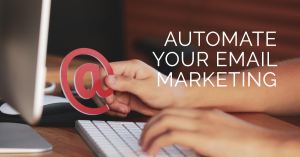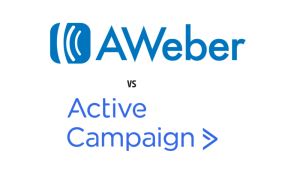In the competitive landscape of email marketing, choosing the right platform can make all the difference in the success of your online marketing endeavours. Aweber vs Mailchimp: Which email marketing platform should you choose? prominent players offering distinct features and capabilities to cater to various business needs. This concise comparison will give you a glimpse into each platform’s critical aspects, helping you make an informed decision for your affiliate marketing website. Whether you’re aiming for simplicity or advanced customization, let’s dive into the essentials of Aweber and Mailchimp to uncover which one aligns best with your goals.
Pricing and Plans: Aweber VS. Mailchimp
Choosing the right email marketing platform is critical for businesses of all sizes. Aweber and Mailchimp are two prominent players in the field, each offering a range of pricing tiers and plans to cater to different needs. In this article, we’ll dive into Aweber and Mailchimp’s pricing structures, highlighting each tier’s key features and limitations to help you make an informed choice for your email marketing strategy.
Aweber Pricing Tiers:
1. Free Plan: Aweber offers a free plan as an entry point for individuals or small businesses with limited subscriber lists. This plan allows you to explore Aweber’s essential features, including email templates, list management, and reporting. However, it comes with some limitations, such as a cap on the number of subscribers and emails per month. While it’s a great starting point, businesses looking to scale may quickly outgrow this plan.
2. Pro Plan: The Pro plan is Aweber’s premium offering, designed to accommodate businesses with more substantial email marketing needs. Priced higher, this plan provides unlimited emails and access to advanced features such as automation, behavioural triggers, and split testing. It also includes integrations with third-party applications, allowing businesses to streamline their marketing efforts. The Pro plan suits those seeking more robust capabilities to enhance their email campaigns and nurture customer relationships.

Mailchimp Pricing Tiers:
1. Free Plan: Similar to Aweber, Mailchimp offers a free plan that allows users to send a limited number of emails to a restricted number of subscribers. While this plan is an excellent way to get started, it includes Mailchimp branding in emails, which may not be suitable for businesses aiming for a professional image. It’s a solid option for small businesses on a tight budget but with certain limitations.
2. Essentials Plan: Mailchimp’s entry-level paid plan is the Essentials plan. It offers advanced features such as marketing automation, custom branding, and access to templates. This plan allows businesses to create more tailored campaigns and track their performance using basic analytics. However, certain features, such as A/B testing and behavioural targeting, are still restricted in this tier.
3. Standard Plan: The plan is geared towards growing businesses requiring more advanced capabilities. It includes all the Essentials plan’s features and benefits, such as A/B testing, behavioural targeting, and access to more templates. This plan also removes the Mailchimp branding from emails, allowing for a more professional and polished appearance in communication with subscribers.
4. Premium Plan: Mailchimp’s Premium plan is tailored for larger businesses with more intricate needs. It offers multivariate testing, advanced segmentation, and priority customer support. This tier also includes phone support for immediate assistance. While it offers a comprehensive suite of features, the Premium plan comes at a higher cost, making it suitable for businesses with larger budgets and complex marketing requirements.
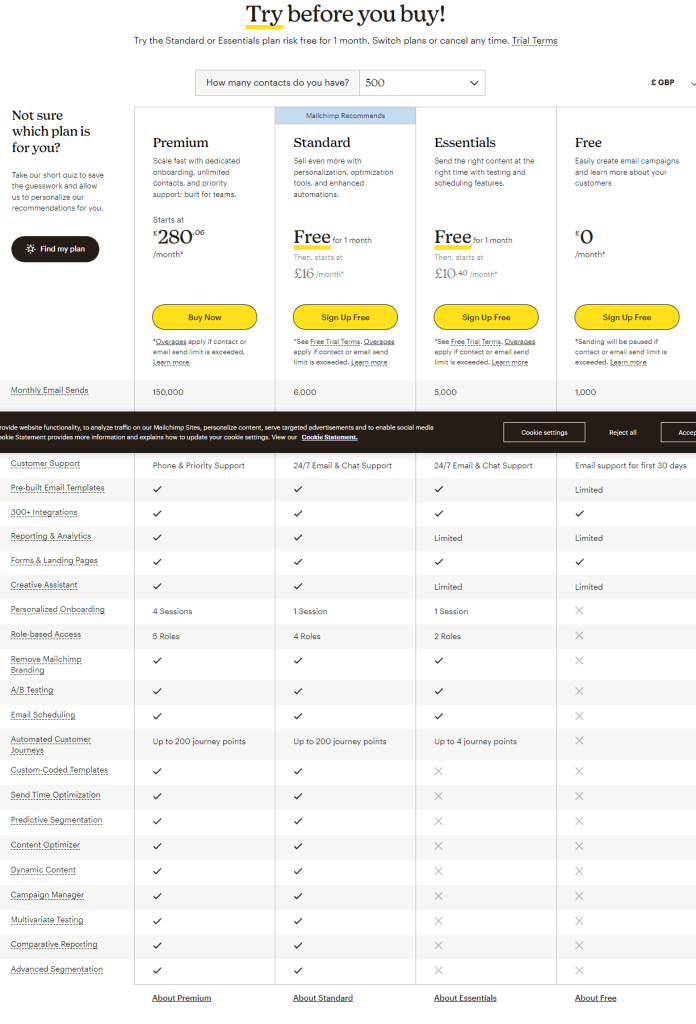
Key Features and Limitations:
- Aweber: The free plan is ideal for beginners and small businesses, but its limitations may hinder growth. The Pro plan unlocks advanced features like automation and split testing, catering to more experienced marketers.
- Mailchimp: The Essentials plan bridges the gap between basic and advanced features, making it suitable for growing businesses. The Standard and Premium plans offer greater customization and testing options, but they come at a higher cost.
In conclusion, Aweber and Mailchimp offer pricing tiers tailored to different business needs. When choosing between the two, carefully assess your requirements, growth potential, and budget to select the plan that aligns with your email marketing strategy and goals.
User Interface and Ease of Use: Aweber vs. Mailchimp
Regarding email marketing platforms, a user-friendly interface can make all the difference in creating efficient and effective campaigns. Both Aweber and Mailchimp prioritize usability, but their approaches to user interfaces can vary. In this section, we’ll explore both platforms’ user interfaces and ease of use to help you make an informed decision for your email marketing endeavours.
Aweber’s User Interface:
Aweber takes pride in its straightforward and intuitive interface, making it an excellent choice for beginners and those new to email marketing. The dashboard offers a clean and organized layout, allowing users to navigate through features easily. The user-friendly design extends to its email editor, which utilizes a drag-and-drop functionality for effortless email creation.
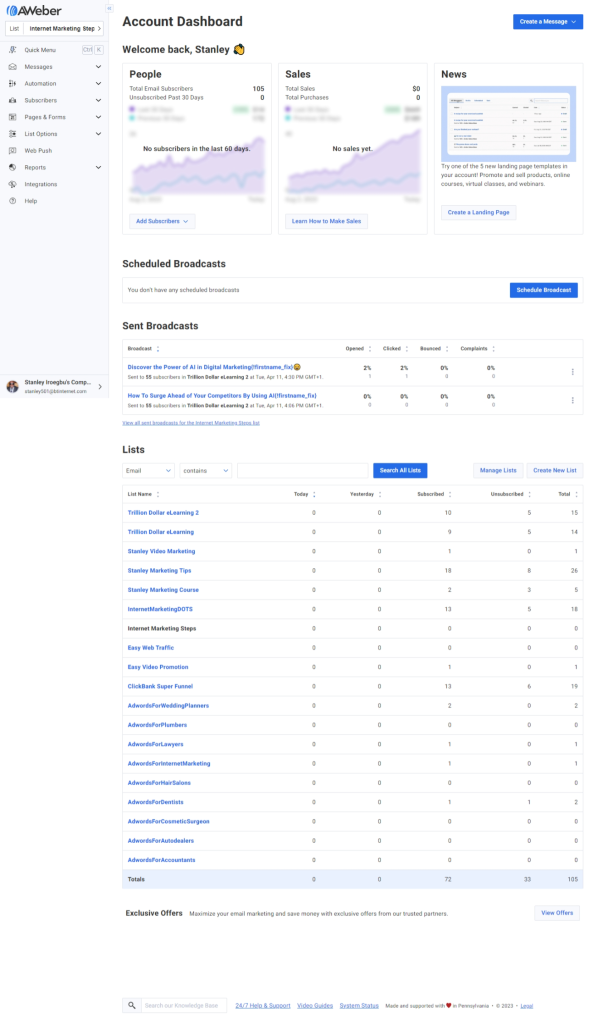
Key Features:
- Simplicity: Aweber’s interface is designed to minimize complexity, providing a smooth learning curve for users of all skill levels.
- Intuitive Navigation: The dashboard’s organized menu and clear labels simplify accessing essential tools and features.
- Email Editor: The drag-and-drop email editor empowers users to create visually appealing emails without coding or design skills.
- Template Library: Aweber’s library of customizable templates further enhances the ease of email creation.
Mailchimp’s User Interface:
Mailchimp also emphasizes an intuitive user interface, though it offers a bit more sophistication in design and customization. The dashboard features a clean design with easy access to various tools. The email editor provides greater flexibility in terms of design elements and layout.
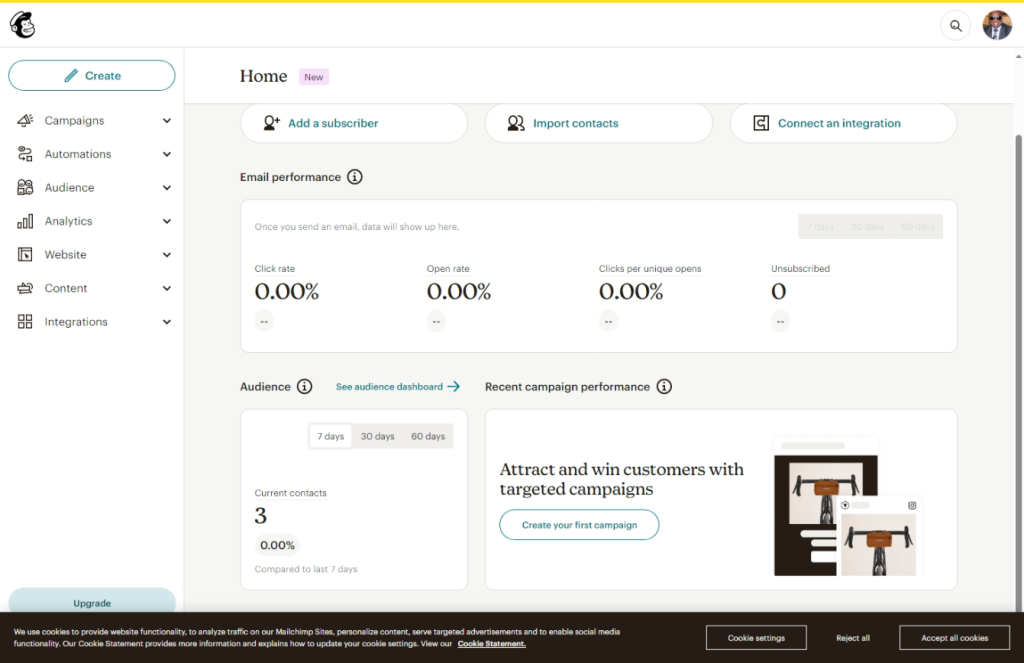
Key Features:
- Visual Appeal: Mailchimp’s interface maintains a modern and visually appealing design, creating an engaging user experience.
- Customization: The email editor offers a higher degree of customization, allowing users to design emails with a unique flair.
- Content Blocks: Mailchimp’s content blocks feature enables users to customize email content layout more comprehensively.
- Template Options: The platform offers templates catering to various industries and styles.
Ease of Use Comparison:
Both Aweber and Mailchimp prioritize ease of use, but the choice between the two depends on your comfort level and design preferences. Aweber’s simplicity is ideal for those who prefer a straightforward approach to email marketing. On the other hand, Mailchimp’s interface may be more suitable for users seeking a slightly more creative and visually engaging platform.
Conclusion:
In the realm of user interface and ease of use, Aweber and Mailchimp excel in their own ways. Aweber’s simplicity is a boon for beginners and small businesses, while Mailchimp’s blend of aesthetics and customization options caters to those seeking more design flexibility. As you evaluate these platforms, consider your comfort with the interface and how it aligns with your email marketing objectives.
Email Templates and Design: Aweber vs. Mailchimp
The visual appeal of your emails plays a crucial role in capturing your audience’s attention and conveying your brand’s message effectively. Both Aweber and Mailchimp offer a variety of email templates and design options, but their approaches and capabilities differ. In this section, we’ll explore both platforms’ email templates and design features to help you decide which aligns better with your branding and marketing goals.
Aweber’s Email Templates and Design:
Aweber’s emphasis on simplicity extends to its email templates and design features. The platform provides a selection of professionally designed templates catering to various industries and campaign types. These templates are optimized for mobile responsiveness, ensuring your emails look great on various devices.
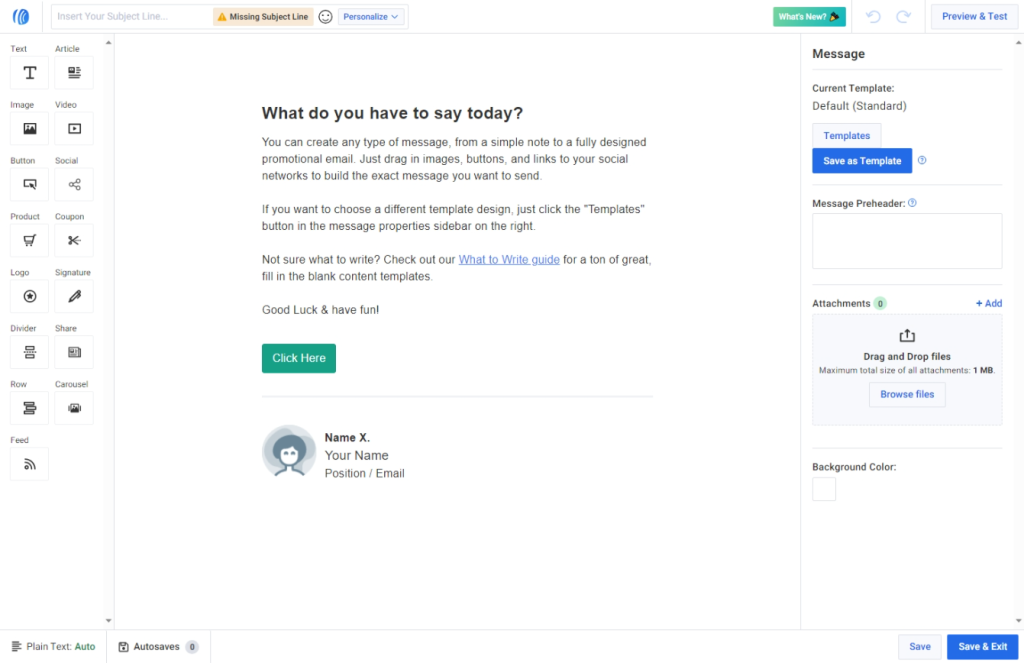
Key Features:
- Template Variety: Aweber offers a collection of ready-to-use templates suitable for newsletters, promotions, announcements, and more.
- Customization: While templates are customizable, Aweber’s design options lean towards the essentials to maintain a user-friendly experience.
- Mobile Responsiveness: All templates are designed to be mobile-responsive, ensuring your emails are well-presented on smartphones and tablets.
- Drag-and-Drop Editor: The intuitive drag-and-drop editor simplifies the process of customizing templates without coding.
Mailchimp’s Email Templates and Design:
Mailchimp strongly emphasises design flexibility, offering various templates and customization options to match various branding needs. The platform’s templates cover diverse aesthetics and industries, empowering users to craft emails that align with their unique style.
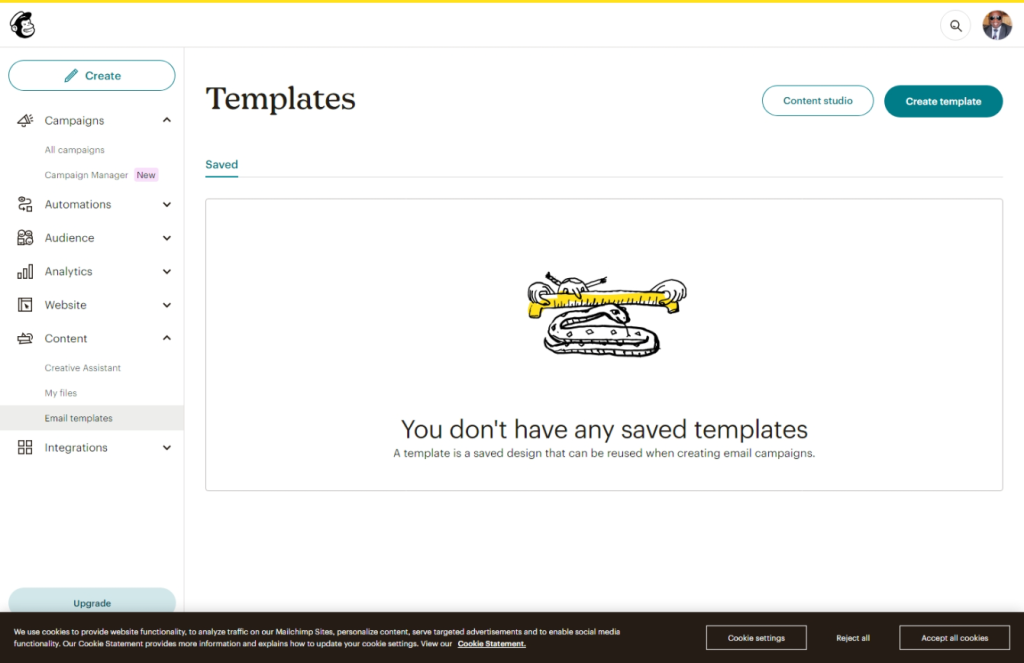
Key Features:
- Template Diversity: Mailchimp’s template library encompasses an extensive range of designs, catering to different industries and design preferences.
- Design Flexibility: The email editor provides more design customization options, including modifying content blocks, colour schemes, and typography.
- Content Blocks: Mailchimp’s feature enables users to create custom layouts and tailor email content to specific needs.
- Mobile Responsiveness: Like Aweber, Mailchimp’s templates are designed to be mobile-responsive, ensuring optimal viewing experiences on all devices.
Email Templates and Design Comparison:
Choosing between Aweber and Mailchimp’s email templates and design features depends on your brand’s aesthetics and customization requirements. Aweber offers simplicity and quick customization, making it ideal for users who prefer a streamlined design process. On the other hand, Mailchimp excels in design flexibility, allowing users to create visually unique emails that reflect their brand’s personality.
Conclusion:
Aweber and Mailchimp provide valuable email templates and design options, catering to different design expertise and creative requirements. As you consider these platforms, consider your brand’s visual identity and how you want to engage your audience through email campaigns. Whether you value simplicity or design freedom, both platforms offer features to help you create visually appealing and compelling email communications.
Automation and Workflows: Aweber vs. Mailchimp
Automation is a cornerstone of modern email marketing, enabling businesses to deliver targeted and timely content to their subscribers. Aweber and Mailchimp are equipped with automation features, but their capabilities and ease of use differ. In this section, we’ll delve into the automation and workflows offered by both platforms to help you determine which one best suits your automation needs.
Aweber’s Automation and Workflows:
Aweber’s automation features are designed to simplify the process of nurturing leads and engaging subscribers over time. The platform offers a range of automation options that are accessible and intuitive for users, making it suitable for businesses looking to automate primary email sequences.
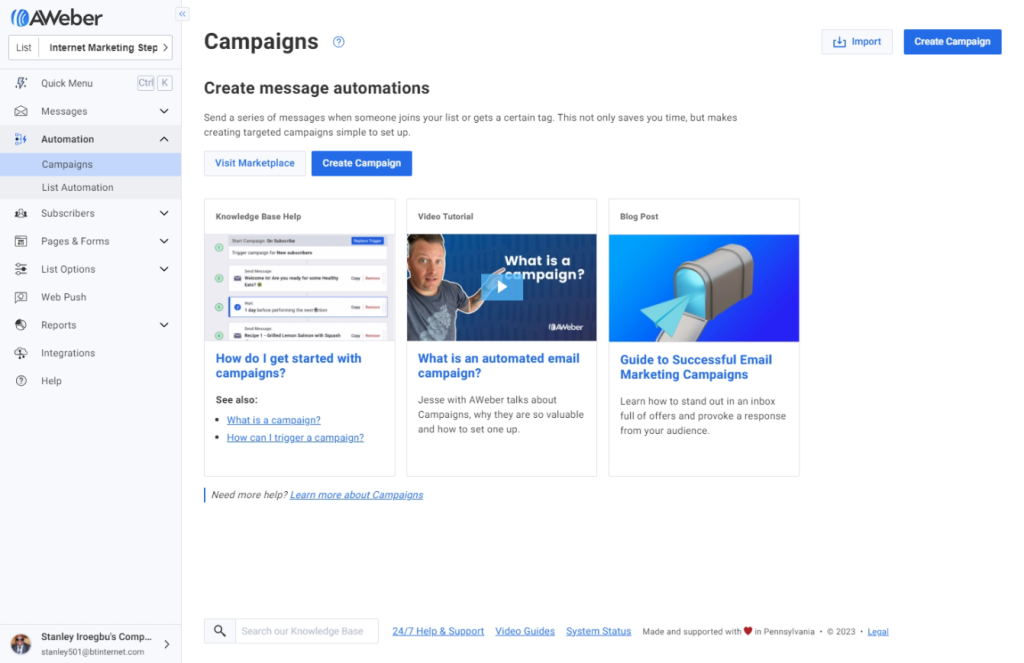
Key Features:
- Automated Campaigns: Aweber’s automation allows you to set up email sequences triggered by specific actions or dates, ensuring timely and relevant communication.
- Tagging and Segmentation: Subscribers can be tagged and segmented based on their interactions, allowing personalized content delivery.
- Autoresponders: Automate welcome emails, thank you messages, and follow-up emails to nurture leads and build relationships.
- Easy Set-Up: Aweber’s user-friendly automation workflows are ideal for beginners new to marketing automation.
Mailchimp’s Automation and Workflows:
Mailchimp’s automation capabilities are more robust, offering advanced workflows to deliver highly personalized content based on subscriber behaviours and preferences. The platform empowers businesses to create intricate automation sequences that drive engagement and conversions.
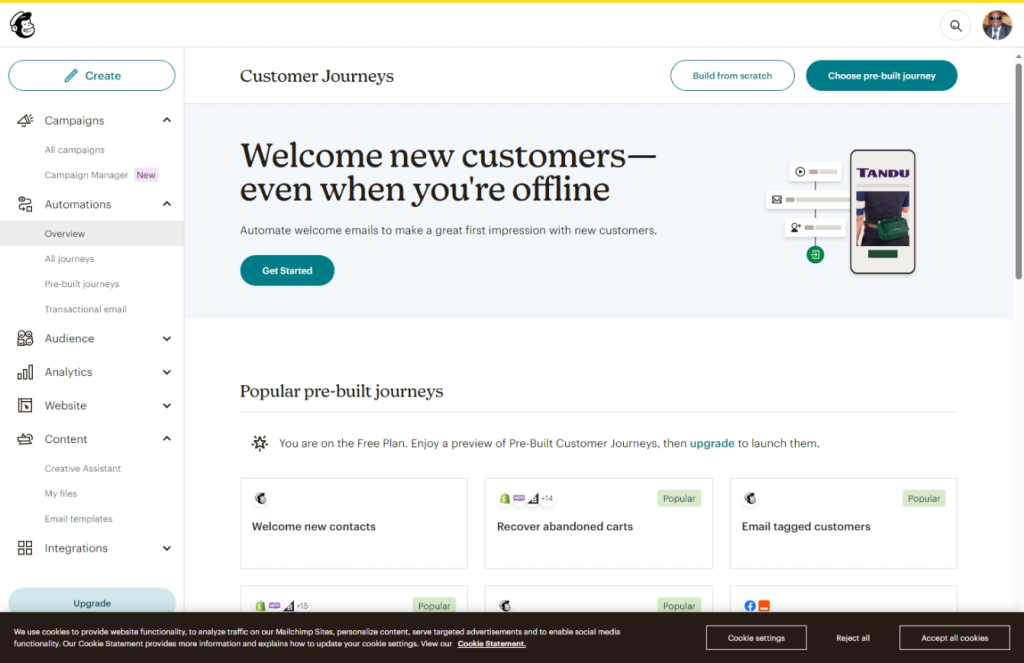
Key Features:
- Behavioural Triggers: Mailchimp’s automation allows you to trigger emails based on specific actions, such as clicks, purchases, or website visits.
- Segmentation and Personalization: Advanced segmentation enables you to send targeted content to specific subscriber groups, enhancing engagement.
- Multi-Step Workflows: Build complex automation sequences with multiple triggers, actions, and conditions to create highly tailored journeys.
- E-Commerce Automation: Mailchimp’s e-commerce automation features help online stores with product recommendations, cart abandonment emails, and more.
Automation and Workflow Comparison:
Aweber is ideal for businesses seeking simple and straightforward automation solutions. Its automation capabilities are accessible to users of all skill levels, making it an excellent choice for beginners or those with basic automation needs. On the other hand, Mailchimp’s automation is more comprehensive and versatile, making it suitable for businesses aiming to create sophisticated and highly personalized customer journeys.
Conclusion:
When considering automation and workflows, your choice between Aweber and Mailchimp depends on the complexity of your automation requirements. Aweber’s user-friendly automation features might suffice if you’re new to marketing automation or need basic sequences. However, if you’re looking to create intricate, behaviour-triggered journeys, Mailchimp’s advanced automation capabilities offer a more tailored approach to engaging your audience and driving conversions
List Management and Segmentation: Aweber vs. Mailchimp
Effectively managing your email subscriber list and delivering targeted content is essential for successful email marketing campaigns. Aweber and Mailchimp offer list management and segmentation features, but their approaches and capabilities vary. This section will explore how each platform handles list management and segmentation, helping you decide which suits your audience’s targeting needs.
Aweber’s List Management and Segmentation:
Aweber provides users with tools to organize and segment their subscriber lists efficiently. While its segmentation features are not as advanced as some other platforms, Aweber offers basic segmentation capabilities that cater to businesses looking to personalize their email content.
Key Features:
- List Organization: Aweber allows you to organize subscribers into different lists, making it easier to manage and target specific groups.
- Tagging: Tagging subscribers based on their behaviours or interests enables you to create more targeted content and campaigns.
- Basic Segmentation: While Aweber’s segmentation capabilities are more straightforward, they still allow for sending more relevant content to specific segments.
Mailchimp’s List Management and Segmentation:
Mailchimp strongly emphasises list management and segmentation, offering a robust suite of features to tailor campaigns to different segments of your audience. This platform’s segmentation capabilities empower you to create highly personalized and targeted content.
Key Features:
- Segmentation Options: Mailchimp’s advanced segmentation options allow you to target subscribers based on their interactions, behaviours, preferences, and more.
- Tags and Groups: Besides lists, Mailchimp uses tags and groups for finer segmentation, enabling you to send precise content to specific subgroups.
- Dynamic Segmentation: Mailchimp offers dynamic content blocks that adapt based on subscriber data, enhancing personalization.
List Management and Segmentation Comparison:
Aweber’s list management and segmentation features suit businesses looking to create primarily targeted campaigns. Its more straightforward approach is user-friendly, making it accessible for those new to email marketing. On the other hand, Mailchimp’s comprehensive list management capabilities are designed for businesses seeking advanced segmentation options to deliver highly personalized content.
Conclusion:
When evaluating Aweber and Mailchimp for list management and segmentation, consider the level of personalization you need for your campaigns. Aweber’s features may suffice if you require straightforward list organization and basic segmentation. However, if you aim to deliver highly targeted content and nurture relationships through advanced segmentation, Mailchimp’s capabilities can empower you to create more personalized and engaging email campaigns.
Deliverability Rates: Aweber vs. Mailchimp
Ensuring your emails reach subscribers’ inboxes is crucial to successful email marketing. Various factors can influence email deliverability rates, including your email marketing platform. This section will explore how Aweber and Mailchimp handle deliverability rates and what you can expect from each platform.
Aweber’s Deliverability Rates:
Aweber places a strong emphasis on email deliverability, working to ensure that your emails reach the intended recipients’ inboxes. The platform employs various strategies to maintain high deliverability rates, including monitoring the sender’s reputation, adhering to best practices, and guiding users.
Key Points:
- Sender Reputation: Aweber actively monitors the sender’s reputation and takes measures to prevent email deliverability issues.
- Compliance: The platform provides resources and guidelines to help users adhere to email marketing best practices and regulations.
- List Hygiene: Aweber emphasizes maintaining clean, engaged subscriber lists to improve deliverability.
Mailchimp’s Deliverability Rates:
Mailchimp also prioritizes email deliverability, implementing measures to help users maximize the chances of their emails landing in subscribers’ inboxes. The platform provides tools and insights to improve deliverability rates and avoid common pitfalls affecting email performance.
Key Points:
- Authentication: Mailchimp supports protocols like SPF, DKIM, and DMARC to verify sender authenticity and enhance deliverability.
- Content Guidelines: The platform recommends optimising email content and avoiding elements that could trigger spam filters.
- Delivery Insights: Mailchimp offers delivery insights and reports that provide information about email performance and engagement.
Deliverability Rates Comparison:
Both Aweber and Mailchimp strive to maintain high email deliverability rates, taking steps to ensure that your emails are successfully delivered to subscribers’ inboxes. Your actual deliverability rates, however, can depend on various factors, including the quality of your content, list hygiene, and adherence to email marketing best practices.
Conclusion:
Regarding email deliverability rates, both Aweber and Mailchimp have mechanisms to help you achieve successful email delivery. While the platforms work to maximize your emails’ chances of reaching subscribers, remember that your practices as an email marketer also play a crucial role. Following best practices, maintaining list hygiene, and crafting engaging content can contribute to higher deliverability rates regardless of your chosen platform.
Reporting and Analytics: Aweber vs. Mailchimp
Analyzing the performance of your email campaigns is essential for refining your strategies and achieving better results. Aweber and Mailchimp offer reporting and analytics tools to provide insights into your emails’ performance. This section will explore how these platforms handle reporting and analytics and what you can expect from each.
Aweber’s Reporting and Analytics:
Aweber provides users with a suite of reporting tools to track the effectiveness of their email campaigns. While the platform’s analytics might not be as extensive as some other platforms, Aweber offers vital metrics to help you gauge the success of your campaigns.
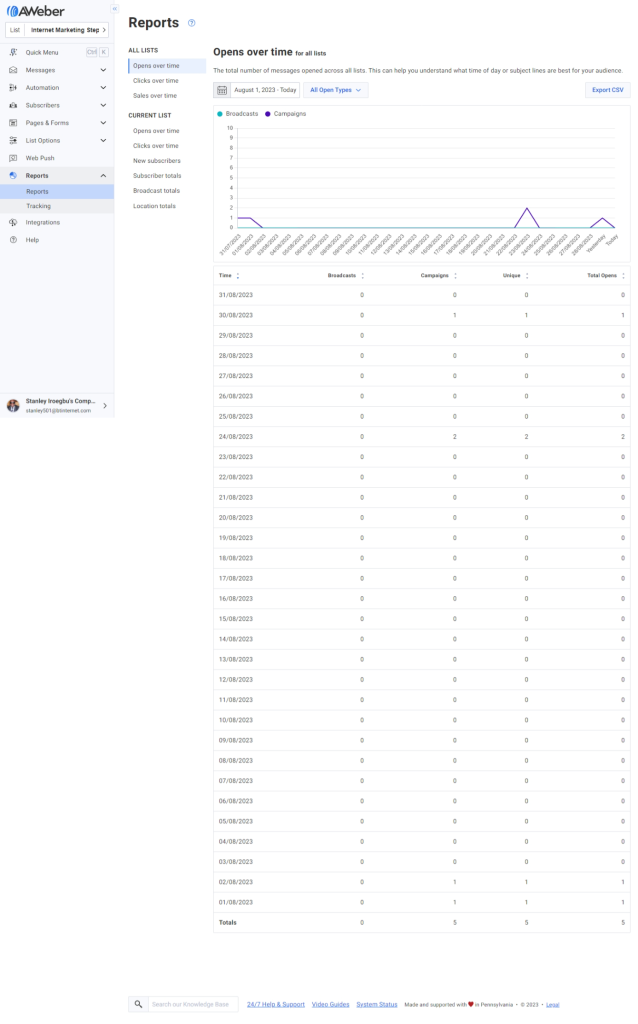
Key Metrics:
- Open Rates: Aweber tracks how many recipients opened your emails, giving you insights into the effectiveness of your subject lines and sender names.
- Click-Through Rates: You can measure the percentage of recipients who clicked on links within your emails, indicating the engagement level of your content.
- Unsubscribe Rates: Aweber allows you to monitor the number of subscribers who opt out of your emails, helping you assess your content relevance.
Mailchimp’s Reporting and Analytics:
Mailchimp offers a comprehensive reporting tool suite to provide in-depth insights into your email campaign performance. The platform’s analytics features allow you to track various metrics and analyze trends.
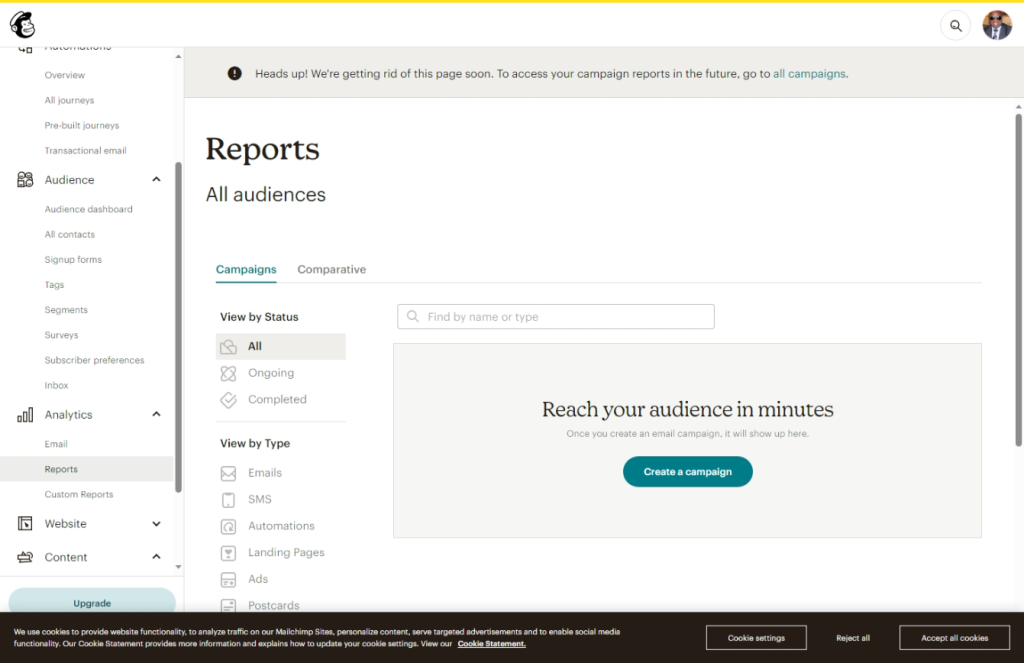
Key Metrics:
- Open and Click Rates: Mailchimp provides detailed open and click rates for individual emails, enabling you to assess the effectiveness of your content and design.
- E-Commerce Data: For e-commerce businesses, Mailchimp’s reporting includes data on revenue generated from email campaigns, helping measure ROI.
- Audience Insights: You can track subscriber growth, engagement patterns, and subscriber demographics to refine your targeting strategies.
Reporting and Analytics Comparison:
While Aweber and Mailchimp offer reporting and analytics features, Mailchimp’s analytics suite is more extensive and detailed. Mailchimp provides a deeper understanding of your campaign’s performance, allowing you to make data-driven decisions and optimize your strategies accordingly.
Conclusion:
If robust reporting and analytics are a priority for your email marketing strategy, Mailchimp’s detailed insights might be more suitable. However, if you’re seeking more straightforward metrics to gauge campaign effectiveness, Aweber’s reporting tools can still provide you with the key information you need to refine your campaigns and improve engagement.
Integrations and Third-Party Apps: Aweber vs. Mailchimp
Seamless integration with other tools and platforms can enhance the effectiveness of your email marketing efforts. Aweber and Mailchimp offer integrations with various third-party apps, allowing you to streamline your workflows and connect your email campaigns with other marketing tools. This section will explore how Aweber and Mailchimp handle integrations and third-party apps.
Aweber’s Integrations and Third-Party Apps:
Aweber offers a selection of integrations with popular tools and platforms, allowing you to extend the capabilities of your email marketing campaigns. While its integrations might not be as extensive as other platforms, Aweber provides essential connections to enhance your marketing stack.
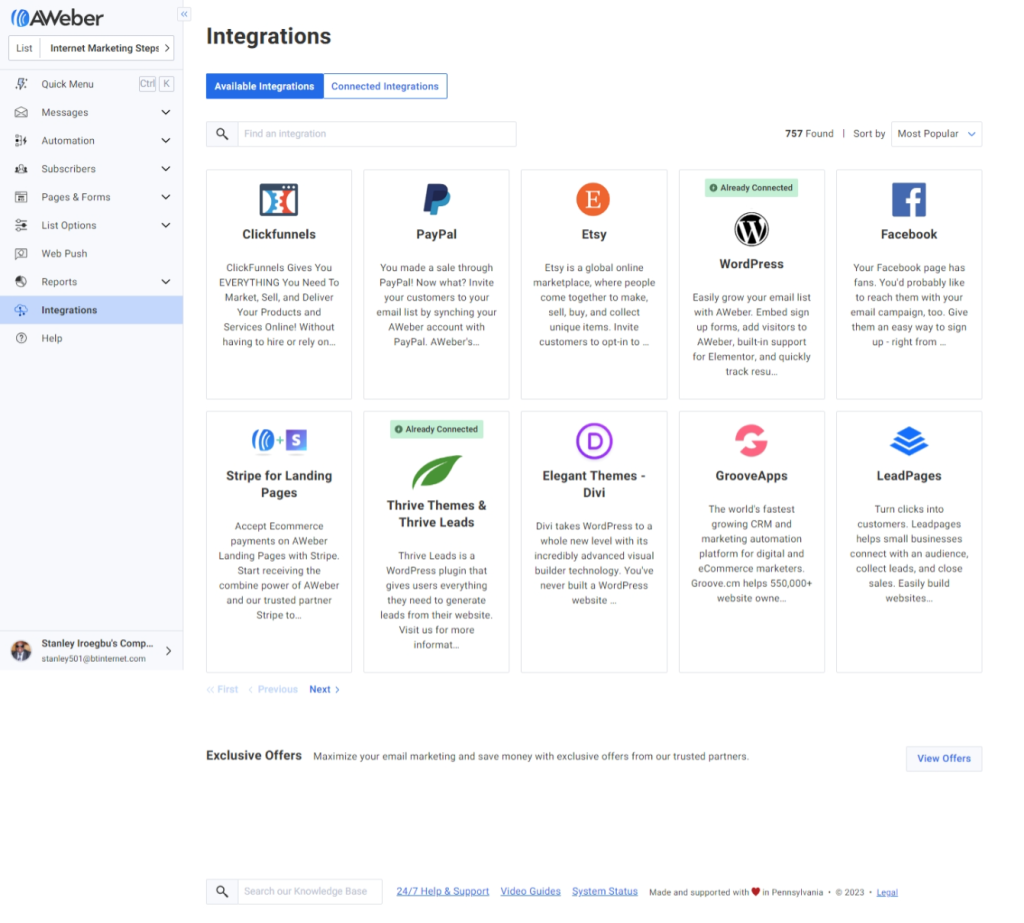
Key Points:
- Basic Integrations: Aweber integrates with tools such as WordPress, Shopify, and PayPal, facilitating e-commerce and content management connections.
- API Access: The platform offers API access for developers to build custom integrations tailored to your business needs.
- Limited Third-Party Apps: While Aweber’s integrations cover essential areas, it might not have integrations with as many third-party apps as other platforms.
Mailchimp’s Integrations and Third-Party Apps:
Mailchimp boasts a wide range of integrations and connections with various third-party apps, making it a versatile choice for businesses looking to create comprehensive marketing workflows. The platform’s extensive integrations allow you to seamlessly synchronize data across multiple tools.
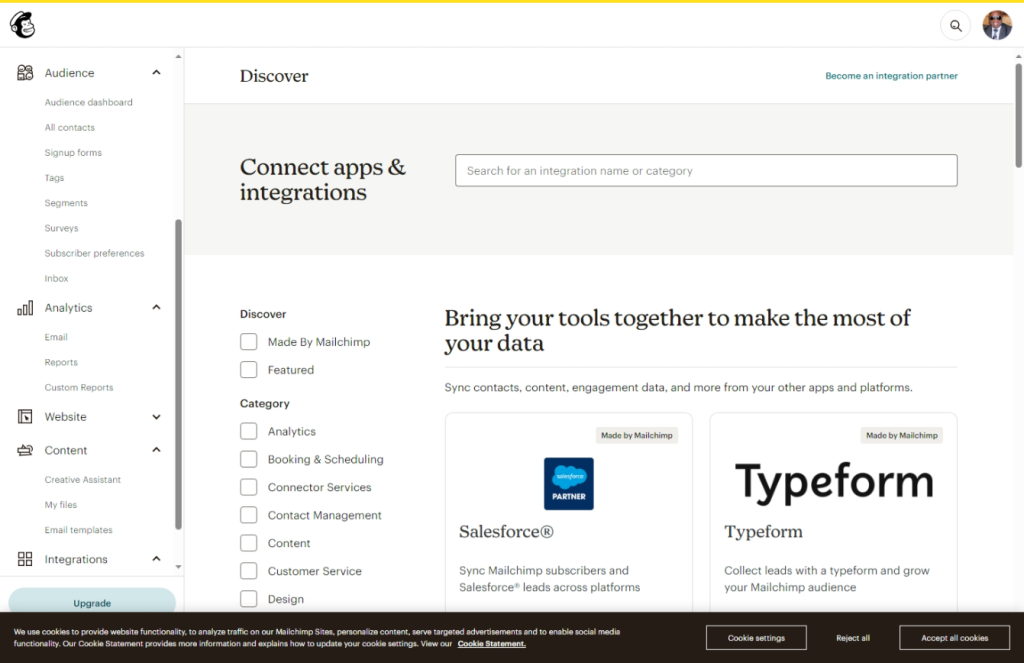
Key Points:
- Extensive App Marketplace: Mailchimp’s app marketplace offers integrations with various tools, including CRM systems, e-commerce platforms, and social media platforms.
- Automation with Integrations: Mailchimp’s integrations allow you to trigger automated campaigns based on actions taken in integrated apps, enhancing personalization.
- Custom Integrations: The platform also provides API access for businesses that require custom integrations tailored to their unique requirements.
Integrations and Third-Party Apps Comparison:
Mailchimp’s extensive integration options give it an edge for businesses seeking a well-connected marketing ecosystem. Its wide array of integrations allows you to consolidate data, automate workflows, and create a seamless customer journey.
Conclusion:
Regarding integrations and third-party apps, Mailchimp’s robust app marketplace offers a broader range of options to extend your marketing capabilities. However, Aweber’s basic integrations can still be sufficient for businesses with more straightforward integration needs. Evaluate your existing toolset and consider how seamlessly each platform can fit into your marketing ecosystem when deciding.
In email marketing, having access to reliable customer support and a wealth of resources can significantly impact your experience with a platform. Both Aweber and Mailchimp understand the importance of assisting their users effectively, but how they offer support and resources can vary. This section will delve into how Aweber and Mailchimp handle customer support and provide valuable resources to help you maximise their platforms.
Aweber’s Customer Support and Resources: Aweber Vs. Mailchimp
Aweber takes pride in offering responsive customer support and a range of resources to guide users through their email marketing journey.
Customer Support Channels:
- Live Chat: Aweber provides live chat support during business hours, allowing you to get instant assistance for your queries.
- Email Support: You can also email Aweber’s support team for more detailed inquiries.
Educational Resources:
- Knowledge Base: Aweber offers a comprehensive knowledge base filled with articles, guides, and tutorials to help users navigate various features.
- Webinars: The platform hosts regular webinars to educate users on email marketing best practices and Aweber-specific tips.
- Blog: Aweber’s blog is valuable for staying updated on industry trends and email marketing insights.
Mailchimp’s Customer Support and Resources:
Mailchimp strongly emphasises providing users various support options and resources to enhance their email marketing expertise.
Customer Support Channels:
- Email and Chat Support: Mailchimp offers email and chat support to address user inquiries promptly.
- Community Forum: The platform has an active community forum where users can engage with each other, ask questions, and share experiences.
Educational Resources:
- Mailchimp Academy: Mailchimp offers a dedicated learning platform, the Mailchimp Academy, where users can access courses on various email marketing topics.
- Guides and Blog: Mailchimp’s guides provide insights into email marketing strategies, industry trends, and platform-specific tips.
Customer Support and Resources Comparison:
Aweber and Mailchimp prioritize customer support and resources, allowing users to get help and learn more about effective email marketing practices. When evaluating these platforms, consider your preferred support channels and the resources that resonate with your learning style.
A/B Testing: Aweber vs. Mailchimp
A/B testing, or split testing, is a crucial strategy for optimizing your email campaigns. It allows you to compare different elements of your emails to determine which versions resonate best with your audience. Aweber and Mailchimp offer A/B testing features, but their approaches and capabilities vary. This section explores how Aweber and Mailchimp handle A/B testing to help you choose the platform that aligns with your testing needs.
Aweber’s A/B Testing:
Aweber offers A/B testing capabilities to help you refine your email campaigns for better engagement and conversion rates. While its A/B testing features are more essential than other platforms, they can still provide valuable insights into optimizing your campaigns.
Key Features:
- Subject Line Testing: Aweber allows you to test different subject lines to determine which generates higher open rates.
- Message Content Testing: You can also test variations in email content to identify the most engaging messaging.
- Basic Reporting: Aweber provides basic reporting on A/B test results to help you make informed decisions.
Mailchimp’s A/B Testing:
Mailchimp’s A/B testing capabilities are more comprehensive, allowing you to experiment with different aspects of your email campaigns and gain deeper insights into audience preferences. The platform’s A/B testing features cover a wide range of elements.
Key Features:
- Variety of Tests: Mailchimp enables you to A/B test subject lines, sender names, content, sending times, and designs.
- Advanced Segmentation Testing: The platform offers more advanced testing by allowing you to compare how different segments of your audience respond to variations.
- In-Depth Reporting: Mailchimp provides detailed reports on A/B test results, helping you understand which variations perform best.
A/B Testing Comparison: Aweber vs. Mailchimp
While Aweber and Mailchimp offer A/B testing features, Mailchimp’s capabilities are more robust and versatile. If you’re looking to conduct more comprehensive tests and gain deeper insights into different elements of your campaigns, Mailchimp’s A/B testing options might be better suited for your needs.
Conclusion:
If A/B testing is a vital part of your email optimization strategy, Mailchimp’s more advanced A/B testing features can provide you with a broader range of testing options and more detailed insights. However, if you’re seeking more straightforward A/B testing capabilities, Aweber’s features can help you refine your email campaigns for better results. Consider the level of testing complexity you require when evaluating these platforms.
GDPR Compliance and Data Security: Aweber vs. Mailchimp
Maintaining data security and complying with regulations such as the General Data Protection Regulation (GDPR) is paramount in email marketing. Aweber and Mailchimp prioritize GDPR compliance and data security, but their approaches and features may differ. In this section, we’ll explore how Aweber and Mailchimp handle GDPR compliance and data security to help you make an informed choice for safeguarding your subscribers’ information.
Aweber’s GDPR Compliance and Data Security:
Aweber takes data protection seriously, aligning its practices with GDPR requirements. The platform provides tools and features to help you manage subscriber data and privacy settings.
Key Points:
- Data Processing Agreement (DPA): Aweber offers a DPA that outlines data protection responsibilities between you and the platform, ensuring compliance with GDPR.
- Subscriber Consent: Aweber allows you to collect explicit consent from subscribers and provides options to manage and document consent.
- Data Management: The platform facilitates data access and deletion requests, empowering subscribers to control their data.
- Security Measures: Aweber employs security measures to protect subscriber data and prevent unauthorized access.
Mailchimp’s GDPR Compliance and Data Security:
Mailchimp also emphasizes GDPR compliance and data security, providing features to help you handle subscriber data responsibly.
Key Points:
- GDPR Resources: Mailchimp offers resources to guide users in understanding and implementing GDPR requirements in their email marketing practices.
- Consent Management: Mailchimp provides tools to collect and document subscriber consent, enabling compliance with GDPR regulations.
- Data Subject Requests: The platform assists in managing data subject requests, including access and deletion requests from subscribers.
- Security Measures: Mailchimp implements security measures to protect data and maintains industry-standard encryption protocols.
GDPR Compliance and Data Security Comparison: Mailchimp vs. Aweber
Aweber and Mailchimp are committed to GDPR compliance and data security, offering tools and features to help you manage and protect subscriber data. Their approaches are aligned with GDPR requirements, providing peace of mind for businesses concerned about data privacy.
Conclusion:
Both platforms prioritise safeguarding subscriber information when evaluating Aweber and Mailchimp for GDPR compliance and data security. Choose the platform that aligns with your data protection values and provides the features you need to adhere to GDPR regulations while maintaining a secure email marketing environment for your subscribers.
Conclusion: Aweber vs. Mailchimp – Choosing Your Email Marketing Partner
As you’ve explored the features and capabilities of Aweber and Mailchimp, it’s evident that both platforms offer valuable tools to enhance your email marketing campaigns. Your final decision should be based on your unique business needs, goals, and priorities. Here’s a recap of the critical factors to consider when choosing between Aweber and Mailchimp:
Critical Factors: Aweber vs. Mailchimp
- Niche Focus: Aweber’s user-friendly interface and simplicity make it an excellent choice for beginners and small businesses. Mailchimp’s design flexibility and extensive integrations cater to those seeking more advanced customization and growth potential.
- Pricing: Aweber’s straightforward pricing structure suits smaller budgets, while Mailchimp’s tiered plans offer scalability and diverse features for growing businesses.
- Automation and Workflows: Aweber’s automation features are ideal for basic automation needs, while Mailchimp’s advanced capabilities suit businesses requiring sophisticated, behavior-triggered campaigns.
- List Management and Segmentation: Aweber’s basic segmentation is user-friendly, while Mailchimp’s advanced options allow for targeted content delivery to specific audience segments.
- Deliverability Rates: Both platforms prioritize email deliverability, ensuring your messages reach subscribers’ inboxes. Your adherence to best practices also plays a role in successful delivery.
- Reporting and Analytics: Mailchimp’s comprehensive reporting provides in-depth insights, while Aweber’s reporting offers essential metrics for campaign assessment.
- Integrations and Third-Party Apps: Mailchimp’s vast app marketplace offers extensive integration options, enhancing your marketing ecosystem. Aweber’s basic integrations may suffice for more straightforward needs.
- A/B Testing: Mailchimp’s advanced A/B testing features provide a wide range of testing options, while Aweber’s features cater to more straightforward testing needs.
- GDPR Compliance and Data Security: Both platforms are committed to GDPR compliance and data security, providing tools to protect subscriber information.
Final Verdict
As you decide, consider your business’s growth trajectory, your familiarity with email marketing tools, and your desire for customization. While both Aweber and Mailchimp have their strengths, the platform that aligns with your objectives will ultimately provide the foundation for compelling, engaging, and successful email marketing campaigns.
Some links in this article may be affiliate links, meaning they could generate compensation to us without any additional cost to you should you choose to purchase a paid plan. These are products we have personally used and confidently endorse. It’s important to note that this website does not offer financial advice. You can review our affiliate disclosure in our privacy policy for more information.

